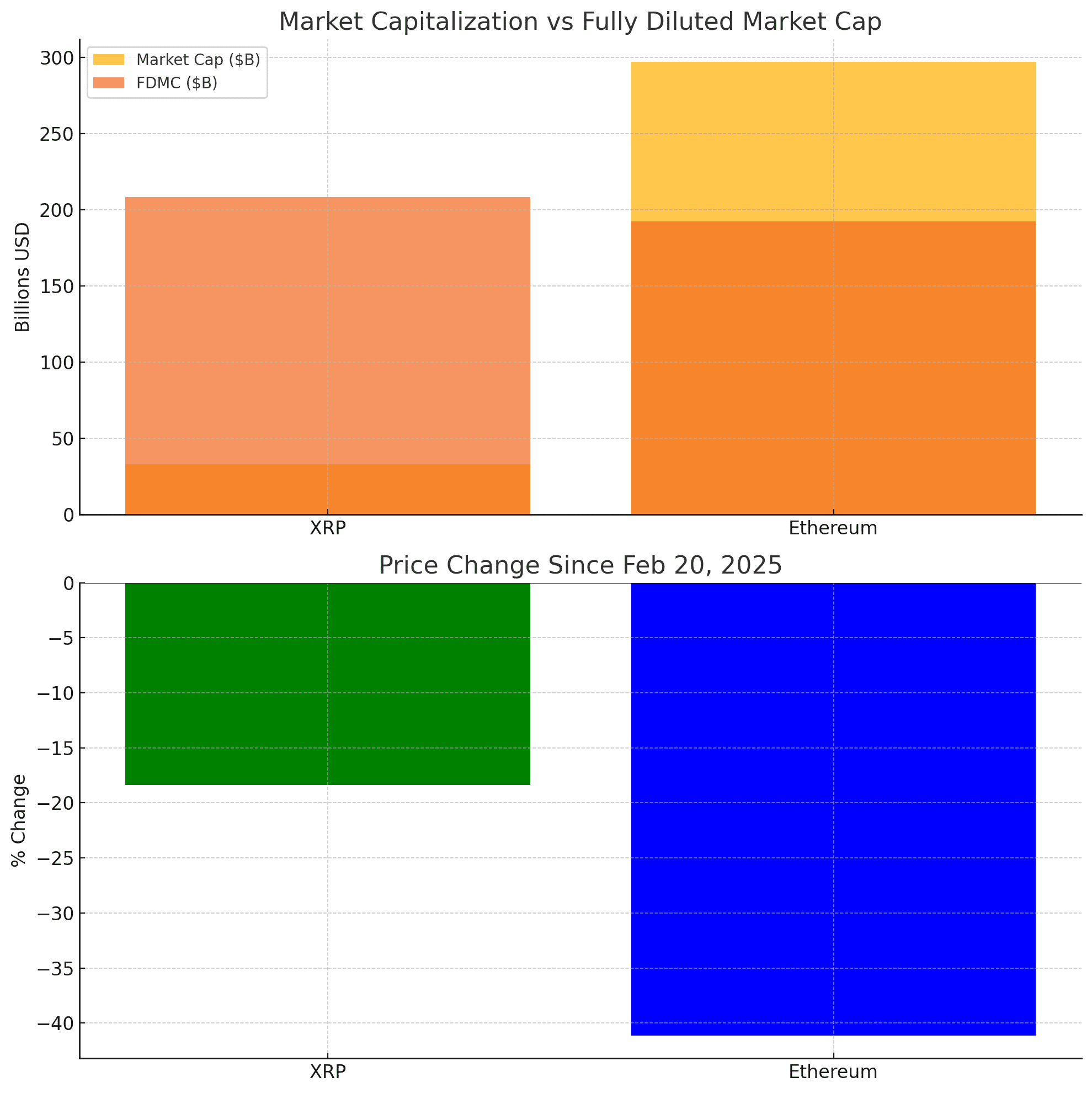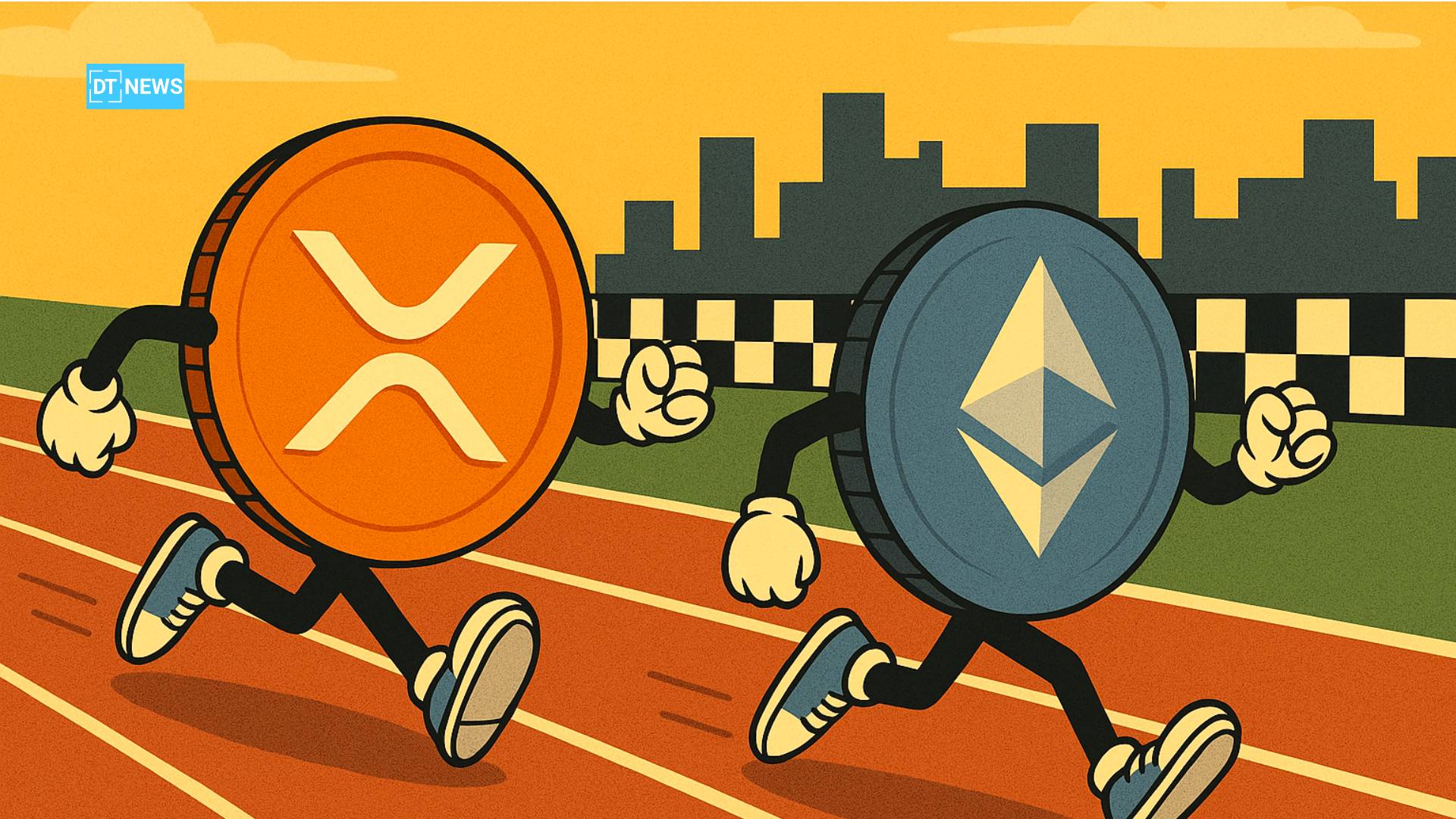The crypto market is no stranger to power shifts — but the question now echoing across the ecosystem is sharper than ever: Could Ripple’s XRP dethrone Ethereum as the dominant altcoin in the next bull cycle? With both giants charting diverging paths in recent months, speculation is mounting as XRP overtakes ETH in fully diluted market capitalization (FDMC), hinting at a brewing rivalry poised to reshape the altcoin landscape.
- XRP Overtakes ETH in Fully Diluted Market Cap — But What Does It Mean?
- Ethereum Still Commands the Smart Contract Frontier
- XRP Gains Momentum from Legal Wins and Cross-Border Payments
- Market Performance: Price Divergence Tells a Story
- Will Ethereum Lose the Altcoin Crown?
- What the Next Bull Cycle Might Reveal
- Final Verdict
- Frequently Asked Questions (FAQs)
- Why did XRP overtake Ethereum in fully diluted market cap?
- Is Ethereum still the most valuable altcoin?
- Which coin has better short-term upside?
- Could XRP replace ETH in the long term?
- Glossary of Key Terms
Below is what the data says, how price trends are unfolding, and whether Ethereum’s top spot is truly under siege — or if XRP is simply enjoying a temporary gust of bullish tailwinds.
XRP Overtakes ETH in Fully Diluted Market Cap — But What Does It Mean?
As of April 18, 2025, XRP’s FDMC hit $208.4 billion, surpassing Ethereum’s $192.5 billion, according to data from AMBCrypto. While this might seem like a seismic shift in altcoin power, a closer look reveals nuance beneath the headlines.
FDMC calculates a token’s value if its entire supply were in circulation. XRP’s supply includes billions of tokens still held in escrow, which inflates its FDMC relative to its circulating market cap. Ethereum, on the other hand, has most of its supply already in circulation.
“This milestone is symbolic, but it does reflect shifting sentiment,” said crypto strategist Eleanor Voss. “Investors are recalibrating risk in light of macro narratives and regulatory clarity.”

Ethereum Still Commands the Smart Contract Frontier
Despite XRP’s impressive rally, Ethereum retains a firm grip on the infrastructure of decentralized finance (DeFi), NFTs, and smart contract deployment. It hosts over 70% of DeFi TVL (Total Value Locked), and its transition to a proof-of-stake model via the Ethereum 2.0 upgrade has significantly reduced energy consumption and bolstered long-term viability.
“Ethereum remains the backbone of decentralized applications,” stated Andre Mackie, a developer at DappForce Labs. “XRP is making inroads, but it’s not replacing Ethereum’s core use cases — at least not yet.”
The gap in utility is underscored by developer activity. Ethereum continues to attract the lion’s share of blockchain developers and remains a favorite for launching Layer-2 protocols like Arbitrum, Optimism, and Base.
XRP Gains Momentum from Legal Wins and Cross-Border Payments
Where Ethereum rules DeFi, XRP has carved a dominant niche in institutional finance and cross-border payments. Ripple Labs’ partial victory against the SEC in 2023 gave XRP a regulatory clarity edge in the U.S., while Ethereum still sits in a legal gray zone, especially under the SEC’s expanded scrutiny of staking services.
Ripple’s technology has been adopted by multiple banks and financial networks, particularly in Asia and the Middle East, bolstering XRP’s reputation as a utility-first asset. Recent pilot programs with central banks have further strengthened its legitimacy as a tool for on-chain settlement.
Market Performance: Price Divergence Tells a Story
From late February to mid-April 2025, XRP declined 18.35%, while Ethereum saw a sharper 41.15% drawdown in the same period. XRP’s price resilience has caught the attention of analysts who note a potential change in investor behavior.
| Token | Current Price | % Change (Since Feb 20, 2025) | Market Cap | FDMC |
|---|---|---|---|---|
| XRP | $0.62 | -18.35% | $33.1 Billion | $208.4 Billion |
| ETH | $2,472 | -41.15% | $297.3 Billion | $192.5 Billion |
Source: CoinMarketCap
Analysts suggest this divergence may be tied to Ethereum’s increased gas fees and a sluggish response to L2 scalability competition, while XRP is gaining institutional flows thanks to regulatory certainty and real-world integration.
Will Ethereum Lose the Altcoin Crown?
The notion of XRP overtaking Ethereum long-term is no longer dismissed outright. As the crypto landscape shifts toward utility-driven narratives and regulatory compliance, XRP’s real-world use case in payments and Ripple’s deep institutional ties position it as a formidable contender.
Still, Ethereum’s strength lies in its decentralized network effects, DeFi dominance, and ongoing innovation. The upcoming EIP-7600 upgrade is expected to further optimize gas efficiency and attract new users. Ethereum’s roadmap also includes potential partnerships with global tech firms for enterprise blockchain solutions.
“A flippening between ETH and XRP would be revolutionary — but it’s not imminent,” said blockchain researcher Tara Nguyen. “It depends on Ethereum’s ability to adapt and XRP’s capacity to scale.”

What the Next Bull Cycle Might Reveal
With the 2025–2026 bull cycle on the horizon, the stage is set for a dramatic face-off. XRP’s momentum is undeniable, and Ethereum’s dip has fueled debates about its vulnerability.
However, market cycles often come with surprises. As institutional inflows rise and token utility becomes central to investment theses, both XRP and ETH could thrive — but possibly in different roles. Ethereum might remain the digital infrastructure for decentralized innovation, while XRP cements its position as a fintech settlement layer.
Final Verdict
While XRP’s ascent past Ethereum in FDMC may signal a paradigm shift, it’s not time to call a winner. The crypto market has matured past “one-chain-to-rule-them-all” narratives. Both Ethereum and XRP are likely to coexist — one as the bedrock of Web3 development, the other as a digital rail for institutional money movement.
The race for altcoin dominance has never been closer — or more compelling.
Frequently Asked Questions (FAQs)
Why did XRP overtake Ethereum in fully diluted market cap?
XRP’s FDMC rose due to market optimism and legal clarity, while a large portion of XRP remains locked in escrow, inflating FDMC relative to circulating supply.
Is Ethereum still the most valuable altcoin?
Yes, in terms of real-world use in DeFi and NFTs, Ethereum remains the top altcoin by network activity and developer engagement.
Which coin has better short-term upside?
XRP has shown a stronger recent performance, but Ethereum may rebound if its next upgrade delivers on scalability and cost efficiency.
Could XRP replace ETH in the long term?
It’s possible in terms of market cap under certain conditions, but they serve different purposes. XRP focuses on payments, while ETH powers decentralized apps.
Glossary of Key Terms
FDMC (Fully Diluted Market Cap): The value of a cryptocurrency if all its tokens were in circulation.
Circulating Market Cap: Market cap based only on tokens currently in circulation.
DeFi (Decentralized Finance): Financial applications built on blockchain without intermediaries.
Gas Fees: Transaction fees on Ethereum’s network.
EIP (Ethereum Improvement Proposal): A design document providing information or new features to Ethereum.



















































































































